Exercises (2276)
Extension and flexion of the arm in a standing position with a forward presentation (left) ► triceps extension
Power
Individual work
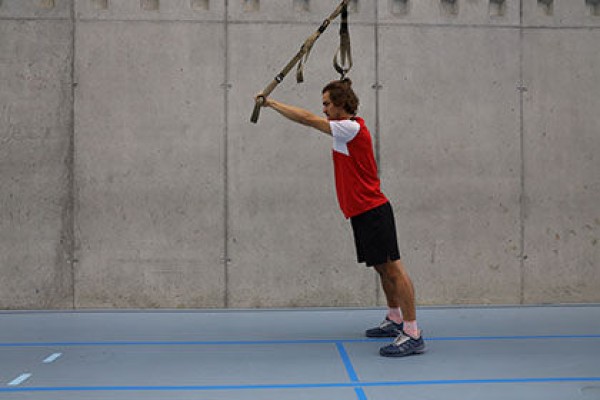
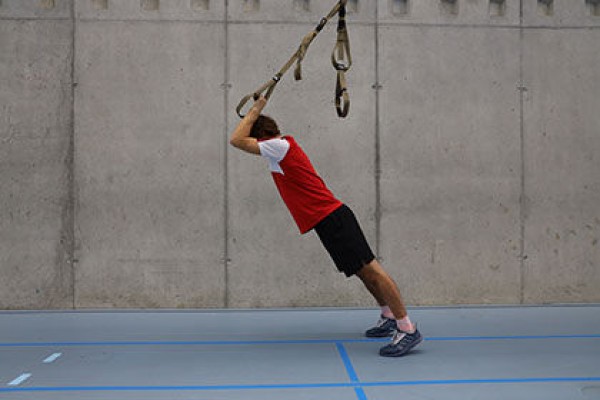
Set the sling trainer to a short length, stand upright (or in a walking position) with your back facing the attachment point, hold the handle with your (left) hand (upper grip) and lean slightly forwards (handle is above your head with your arm raised), stretch and bend your arm (raise and lower your upper body).
Attention:
The position of the elbow/upper arm remains stable (movement only from the elbow joint), maintain body tension, do not sag at the hips, no hollow back.
Harden:
The more horizontal the starting position, the more challenging the exercise.
Variant:
The exercise can also be performed with both arms on the handles (organisation = 1 exercise).
1 sling trainer
Extension and flexion of the arm in a standing position with forward presentation (right) ► triceps extension
Power
Individual work

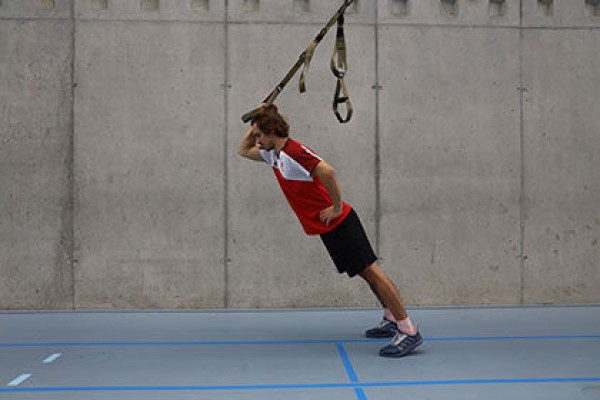
Set the sling trainer to a short length, stand upright (or in a walking position) with your back facing the attachment point, hold the handle with your (right) hand (upper grip) and lean slightly forwards (handle is above your head with your arm raised), stretch and bend your arm (raise and lower your upper body).
Attention:
The position of the elbow/upper arm remains stable (movement only from the elbow joint), maintain body tension, do not sag at the hips, no hollow back.
Harden:
The more horizontal the starting position, the more challenging the exercise.
Variant:
The exercise can also be performed with both arms on the handles (organisation = 1 exercise).
1 sling trainer
Extension and flexion of the arm in four-footed stance (left) ► triceps extension
Power
Individual work

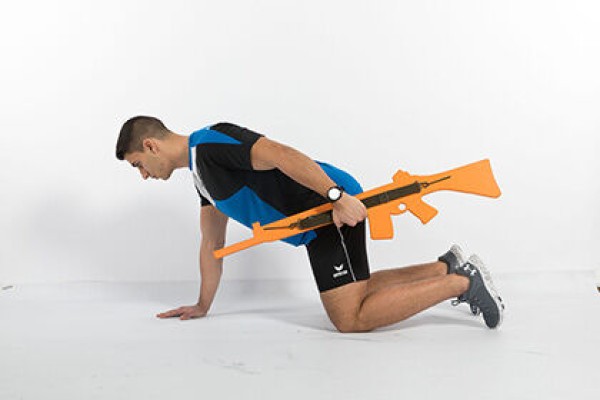
Four-foot stance, hold the weapon in one hand (left) on the hand guard parallel to the body (neutral grip) and raise the arm slightly (upper arm resting against the upper body, 90 degree angle in the elbow joint, barrel of the weapon pointing forwards in the direction of vision), extend the arm backwards into a horizontal position (barrel of the weapon pointing towards the ground) and bend back to the starting position.
Attention:
The movement is only performed from the elbow (upper arm remains stable against the body).
1 assault rifle (neutralised)
Extension and flexion of the arm in quadruped stance (right) ► triceps extension
Power
Individual work

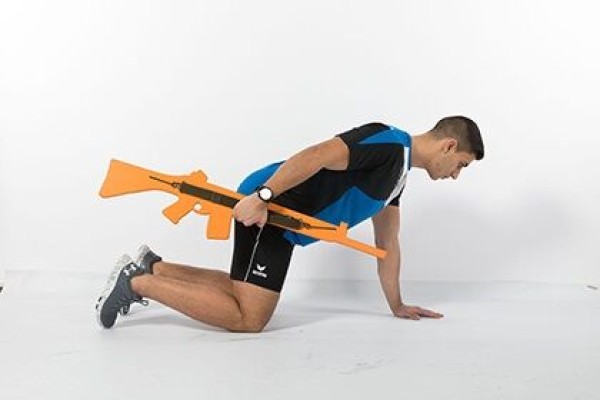
Four-foot stance, hold the weapon in one hand (right) on the hand guard parallel to the body (neutral grip) and raise the arm slightly (upper arm resting against the upper body, 90 degree angle in the elbow joint, barrel of the weapon pointing forwards in the direction of vision), extend the arm backwards into a horizontal position (barrel of the weapon pointing towards the ground) and bend back into the starting position.
Attention:
The movement is only performed from the elbow (upper arm remains stable against the body).
1 assault rifle (neutralised)
Extension and flexion of the arm in four-foot stance (rowing pull) (left) ► bird row 1-arm
Power
Individual work
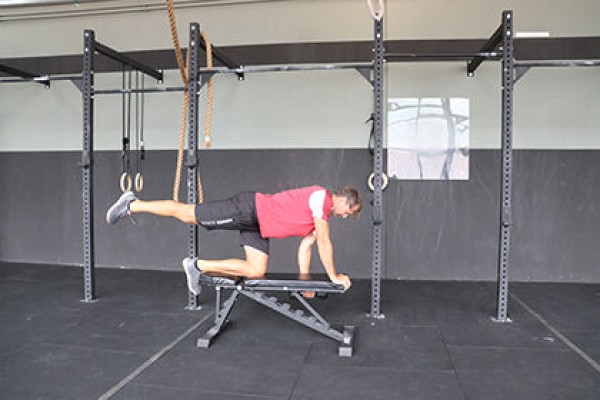
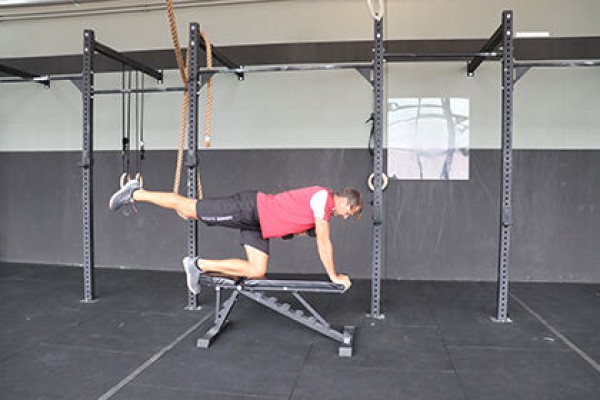
Four-foot stance, one leg (right) extended backwards in extension of the body, the arm on the same side of the extended leg supported on the (flat) bench, almost extended free training arm (left) holds the dumbbell/kettlebell and points towards the floor, bend the free arm (bring the elbow back up) to move the weight towards the abdomen and extend back to the starting position.
Starting position:
- Four-foot stance, one leg extended backwards in extension of the body
- Arm on the side of the extended leg supports the upper body on the bench
- Training arm almost extended points towards the floor
Finishing position:
- Training arm bent, pull dumbbell/kettlebell up to upper abdomen
- Move elbows as far back as possible
Harden:
Always make sure your back is straight (tense torso). The angle of your back and thighs should remain the same throughout the exercise. Pull your elbows back and up (stay close to your body).
1 flat bench
1 dumbbell/kettlebell
Extension and flexion of the arm in four-foot stance (rowing pull) (right) ► bird row 1-arm
Power
Individual work
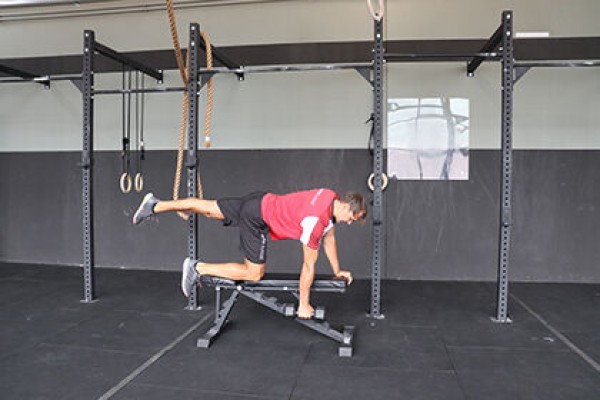
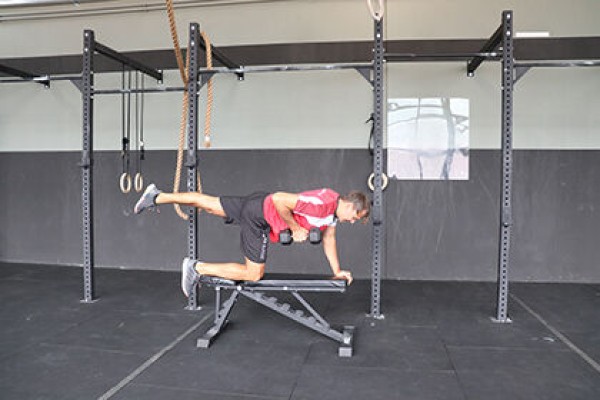
Four-foot stance, one leg (left) extended backwards in extension of the body, the arm on the same side of the extended leg supported on the (flat) bench, almost extended free training arm (right) holds the dumbbell/kettlebell and points towards the floor, bend the free arm (bring the elbow back up) to move the weight towards the abdomen and extend back to the starting position.
Starting position:
- Four-foot stance, one leg extended backwards in extension of the body
- Arm on the side of the extended leg supports the upper body on the bench
- Training arm almost extended points towards the floor
Finishing position:
- Training arm bent, pull dumbbell/kettlebell up to upper abdomen
- Move elbows as far back as possible
Attention:
Always make sure your back is straight (tense torso). The angle of your back and thighs should remain the same throughout the exercise. Pull your elbows back and up (stay close to your body).
1 flat bench
1 dumbbell/kettlebell
Extension and flexion of the arm in the standing balance (rowing pull) (left) ► row 1-arm/1-leg
Power
Individual work
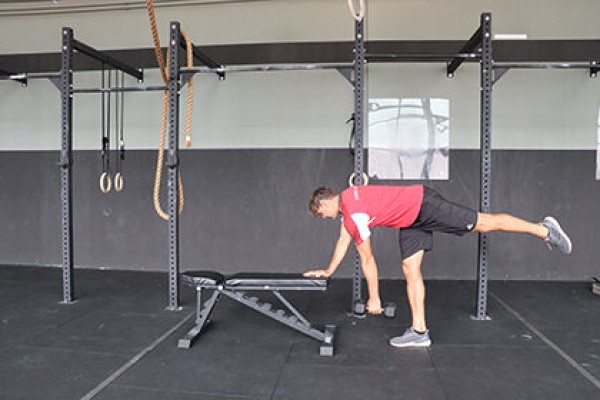
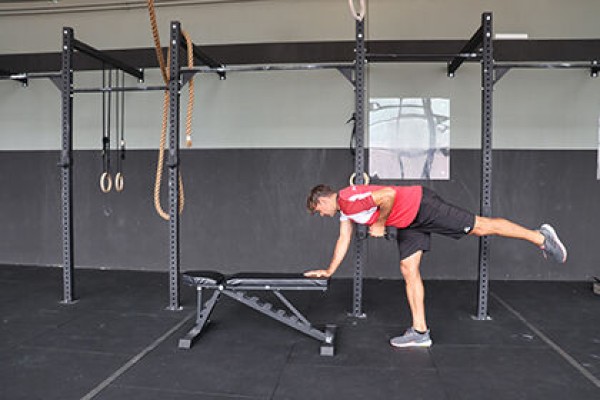
Standing balance, the hand (left) over the cross of the supporting leg (right) holds the dumbbell/kettlebell, to stabilise the balance the free hand can be supported on a (flat) bench, both arms are almost stretched out and point towards the floor, bend the training arm (elbow points backwards upwards) to move the weight towards the abdomen and stretch back to the starting position.
Starting position:
- Standing balance, knees of the supporting leg slightly bent
- Upper body leaning forwards, back straight, one leg stretched out behind in extension of the body
- Arms almost extended, pointing towards the floor
- Crossed arm of the supporting leg holds the dumbbell
- Free arm can be supported on a bench to help maintain balance
Finishing position:
- Training arm bent, pull dumbbell/kettlebell up to upper abdomen
- Move elbows as far back as possible
Attention:
Always make sure your back is straight (tense torso). The angle of your back and thighs should remain the same throughout the exercise. Pull your elbows back and up (stay close to your body).
Variant:
Playing arm and supporting leg correspond to the same side.
1 dumbbell/kettlebell
1 flat bench (optional)
Extension and flexion of the arm in the standing balance (rowing pull) (left) ► row 1-arm/1-leg
Power
Individual work

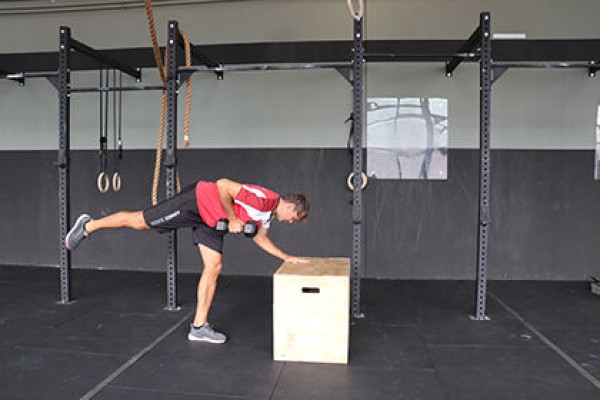
Standing balance, the hand (left) over the cross of the standing leg (right) holds the dumbbell/kettlebell, to stabilise the balance the free hand is supported on a swinging box, both arms are almost stretched out and point towards the floor, bend the training arm (elbow points backwards upwards) to move the weight towards the chest and stretch back to the starting position.
Attention:
Always make sure your back is straight (keep your core tensed). The angle of the back and thighs remains unchanged throughout the exercise. Pull your elbows back and up (stay close to your body).
Lighten:
Less weight.
Harden:
Without support (balance); more weight/increased load.
Variation:
Play arm and supporting leg on the same side.
1 vaulting box/plyo box
1 dumbbell/kettlebell
Extension and flexion of the arm in the standing balance (rowing pull) (left) ► row 1-arm/1-leg
Power
Individual work
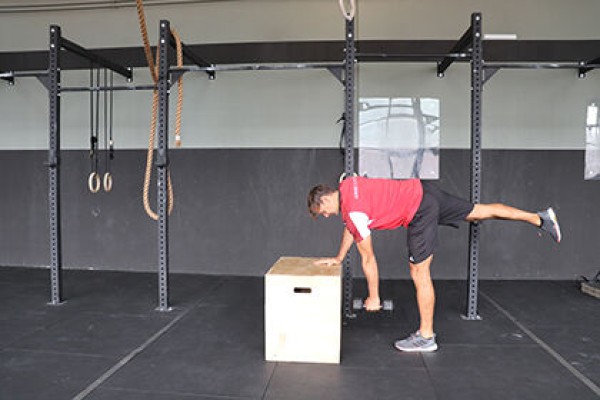
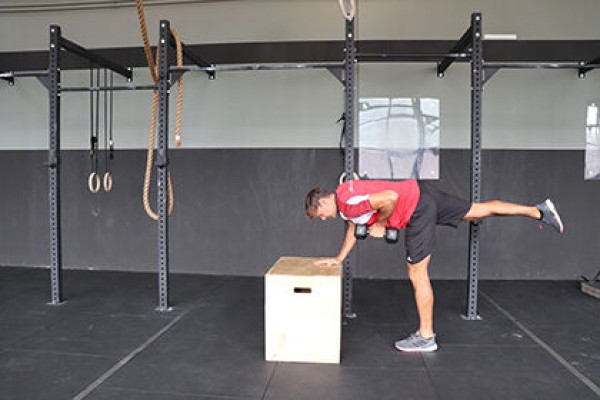
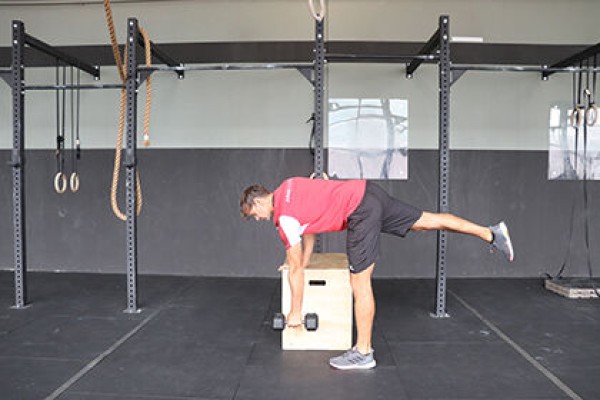
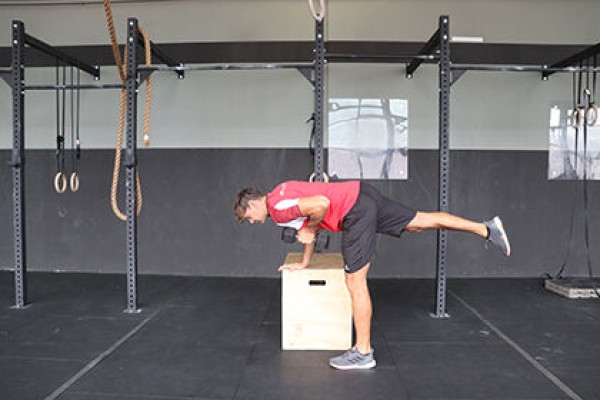
Standing balance, the hand (left) on the same side of the standing leg (left) holds the dumbbell/kettlebell, to stabilise the balance the free hand is supported on a swinging box, both arms are almost stretched out and point towards the floor, bend the training arm (elbow points backwards upwards) to move the weight towards the chest and stretch back to the starting position.
Attention:
Always make sure your back is straight (keep your core tensed). The angle of the back and thighs remains unchanged throughout the exercise. Pull your elbows back and up (stay close to your body).
Lighten:
Less weight.
Harden:
Without support (balance); more weight/increased load.
Variant:
Play arm with weight in hand and supporting leg crossed.
1 Swedish box/pyo box
1 dumbbell/kettlebell
Extension and flexion of the arm in the standing balance (rowing pull) (left) ► row 1-arm/1-leg
Power
Individual work
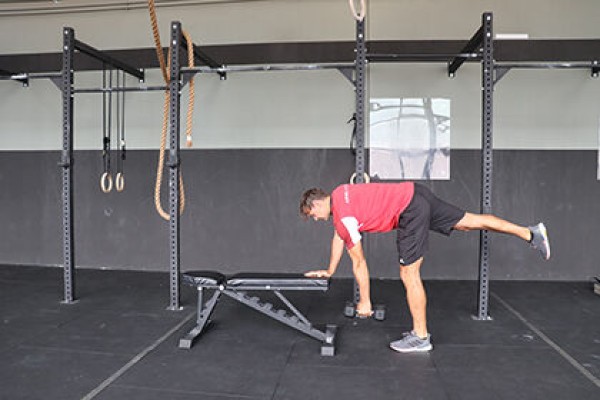
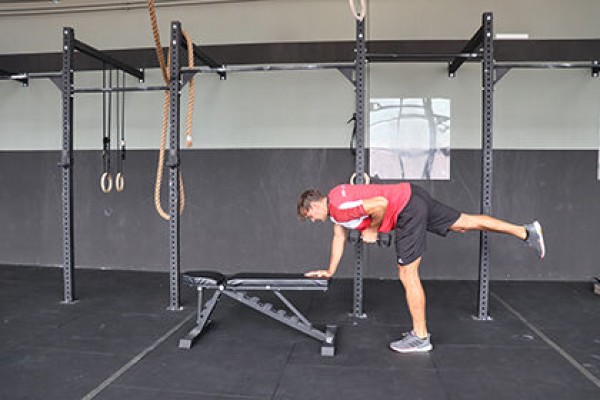
Standing balance, the hand (left) on the same side of the body as the standing leg (left) holds the dumbbell/kettlebell, to stabilise the balance the free hand can be supported on a (flat) bench, both arms are almost stretched out and point towards the floor, bend the training arm (elbow points backwards upwards) to move the weight towards the abdomen and stretch back to the starting position.
Starting position:
- Standing balance, knees of the supporting leg slightly bent
- Upper body tilted forwards, back straight, one leg stretched out behind in extension of the body
- Arms are almost straight, pointing towards the floor
- Arm on the same side of the supporting leg holds the dumbbell
- Free arm can be supported on a bench to help maintain balance
Finishing position:
- Training arm bent, pull dumbbell/kettlebell up to the upper abdomen
- Move elbows as far back as possible
Attention:
Always make sure your back is straight (tense torso). The angle of your back and thighs should remain the same throughout the exercise. Pull your elbows back and up (stay close to your body).
Variant:
Cross your playing arm and supporting leg.
1 dumbbell/kettlebell
1 flat bench (optional)
Extension and flexion of the arm in the standing balance (rowing pull) (right) ► row 1-arm/1-leg
Power
Individual work


Standing balance, the hand (right) over the cross of the supporting leg (left) holds the dumbbell/kettlebell, to stabilise the balance the free hand can be supported on a (flat) bench, both arms are almost stretched out and point towards the floor, bend the training arm (elbow points backwards upwards) to move the weight towards the abdomen and stretch back to the starting position.
Starting position:
- Standing balance, knees of the supporting leg slightly bent
- Upper body leaning forwards, back straight, one leg stretched out behind in extension of the body
- Arms are almost straight, pointing towards the floor
- Crossed arm of the supporting leg holds the dumbbell
- Free arm can be supported on a bench to help maintain balance
Finishing position:
- Training arm bent, pull dumbbell/kettlebell up to upper abdomen
- Move elbows as far back as possible
Attention:
Always make sure your back is straight (tense torso). The angle of your back and thighs should remain the same throughout the exercise. Pull your elbows back and up (stay close to your body).
Variant:
Playing arm and supporting leg correspond to the same side.
1 dumbbell/kettlebell
1 flat bench (optional)
Extension and flexion of the arm in the standing balance (rowing pull) (right) ► row 1-arm/1-leg
Power
Individual work
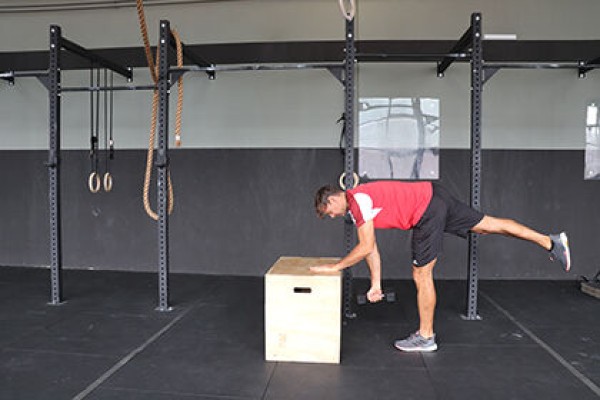
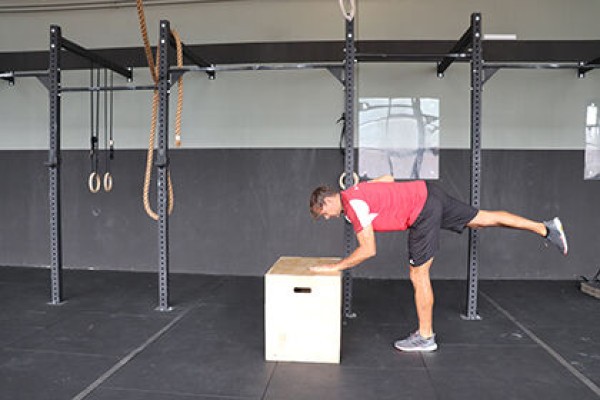
Standing balance, the hand (right) over the cross of the standing leg (left) holds the dumbbell/kettlebell, to stabilise the balance the free hand is supported on a swinging box, both arms are almost stretched out and point towards the floor, bend the training arm (elbow points backwards upwards) to move the weight towards the chest and stretch back to the starting position.
Attention:
Always make sure your back is straight (keep your core tensed). The angle of the back and thighs remains unchanged throughout the exercise. Pull your elbows back and up (stay close to your body).
Lighten:
Less weight.
Harden:
Without support (balance); more weight/increased load.
Variation:
Play arm and supporting leg on the same side.
1 vaulting box/plyo box
1 dumbbell/kettlebell
Extension and flexion of the arm in the standing balance (rowing pull) (right) ► row 1-arm/1-leg
Power
Individual work
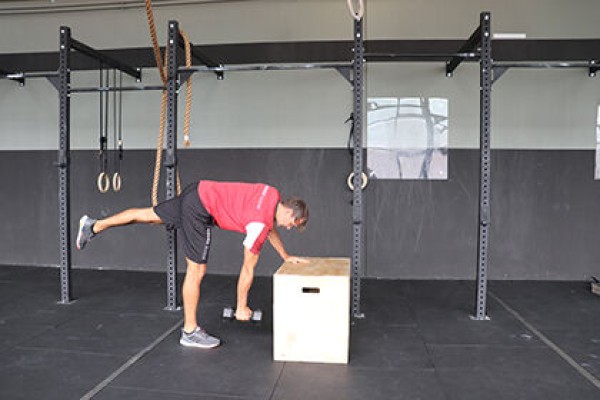

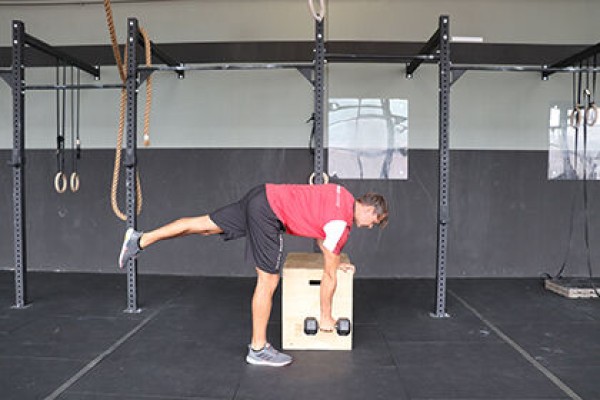
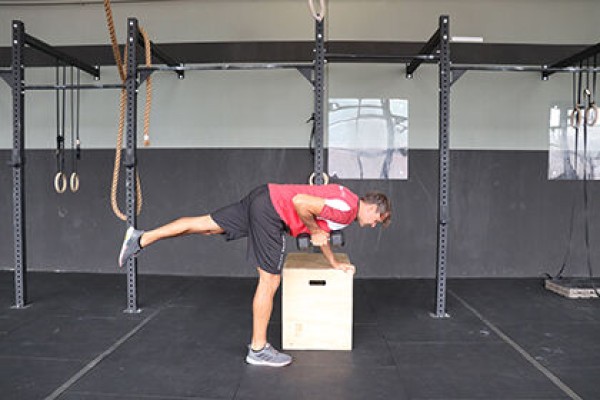
Standing balance, the hand (right) on the same side of the standing leg (right) holds the dumbbell/kettlebell, to stabilise the balance the free hand is supported on a swinging box, both arms are almost stretched out and point towards the floor, bend the training arm (elbow points backwards upwards) to move the weight towards the chest and stretch back to the starting position.
Attention:
Always make sure your back is straight (keep your core tensed). The angle of the back and thighs remains unchanged throughout the exercise. Pull your elbows back and up (stay close to your body).
Lighten:
Less weight.
Harden:
Without support (balance); more weight/increased load.
Variant:
Play arm with weight in hand and supporting leg crossed.
1 vaulting box/plyo box
1 dumbbell/kettlebell
Extension and flexion of the arm in the standing balance (rowing pull) (right) ► row 1-arm/1-leg
Power
Individual work
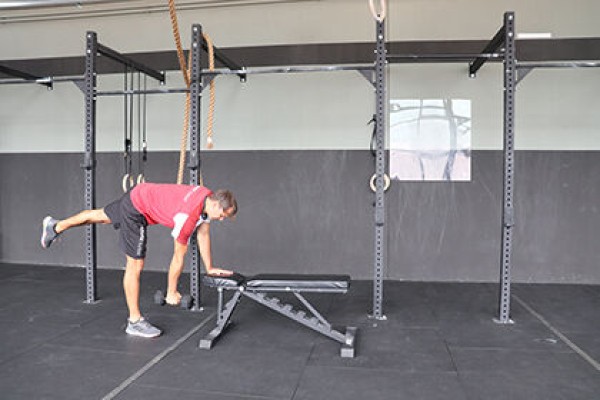
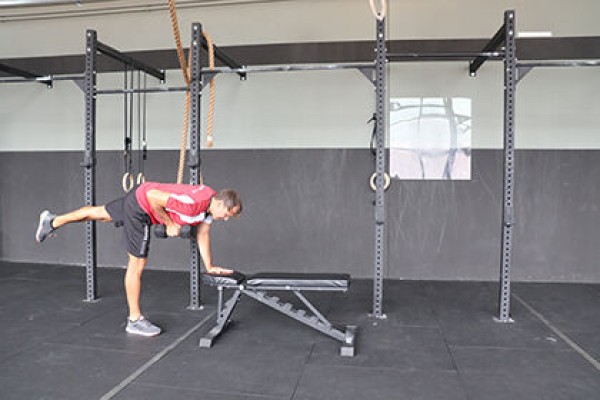
Standing balance, the hand (right) on the same side of the body as the standing leg (right) holds the dumbbell/kettlebell, to stabilise the balance the free hand can be supported on a (flat) bench, both arms are almost stretched out and point towards the floor, bend the training arm (elbow points backwards upwards) to move the weight towards the abdomen and stretch back to the starting position.
Starting position:
- Standing balance, knees of the supporting leg slightly bent
- Upper body tilted forwards, back straight, one leg stretched out behind in extension of the body
- Arms are almost straight, pointing towards the floor
- Arm on the same side of the supporting leg holds the dumbbell
- Free arm can be supported on a bench to help maintain balance
Finishing position:
- Training arm bent, pull dumbbell/kettlebell up to the upper abdomen
- Move elbows as far back as possible
Attention:
Always make sure your back is straight (tense torso). The angle of your back and thighs should remain the same throughout the exercise. Pull your elbows back and up (stay close to your body).
Variant:
Cross your playing arm and supporting leg.
1 dumbbell/kettlebell
1 flat bench (optional)
Extension and flexion of the arm in a kneeling position with the upper body supported (left) ► triceps extension
Power
Individual work
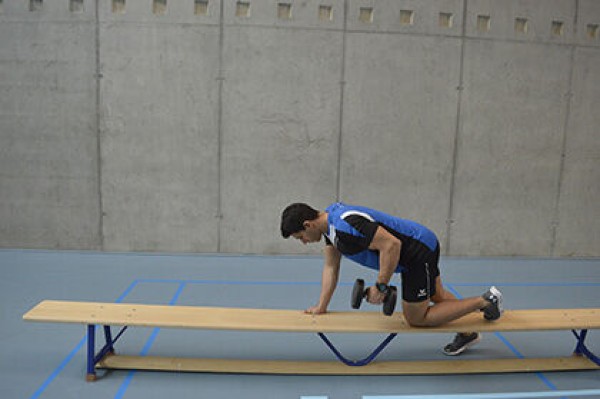

One-legged stand on the right, other leg (left) kneeling on the long bench (knee height of standing leg), one-armed support of the upper body on the long bench (supporting arm on the side of the standing leg), free arm (left) with the dumbbell in the hand close to the body stretched backwards in extension of the body, bend arm/elbow (approx. 90 degrees in the elbow joint) and stretch back to the starting position (raise weight). 90 degrees at the elbow joint) and stretch back to the starting position (lift and lower the weight).
Attention:
Upper arm remains fixed (movement only at the elbow joint), straight back.
Lighten:
Less weight.
Harden:
More weight.
1 long bench
1 dumbbell
Extension and flexion of the arm in a kneeling position with the upper body supported (left) ► triceps extension
Power
Individual work
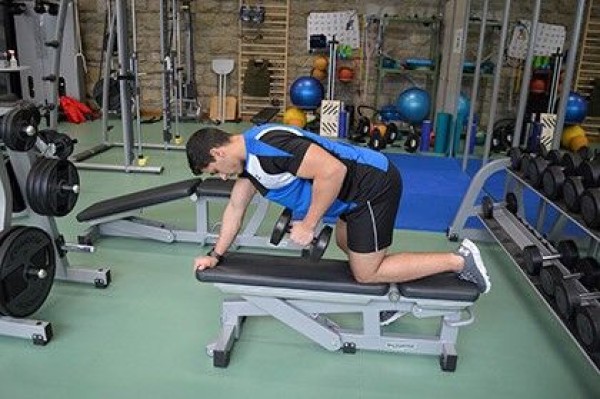

The body is supported with one knee and one arm on the flat bench (same side of the body, right). The other (left) foot is placed on the floor and the dumbbell is held in a neutral grip with the free (left) arm. The training arm is bent (approx. 90 degrees) so that the upper arm rests against the body (horizontal) and the lower arm points towards the floor (vertical). The arm is now stretched to bring the forearm into a horizontal position. The rest of the body remains still. Then bend the arm back to the starting position.
Starting position:
- Body is supported with one knee and one arm on the flat bench (same side of the body)
- Dumbbell in neutral grip
- Upper arm of the training arm is parallel to the back against the body
- Lower arm of the training arm points towards the floor (right angle in the elbow joint)
Finishing position:
- Training arm is parallel to the floor (stretched)
- Wrist remains stable
- Rest of body remains unchanged in the starting position.
Attention:
The movement (bringing the forearm into a horizontal position) is only performed from the elbow joint.
1 flat bench
1 dumbbell
Extension and flexion of the arm in a kneeling position with the upper body supported (right) ► triceps extension
Power
Individual work
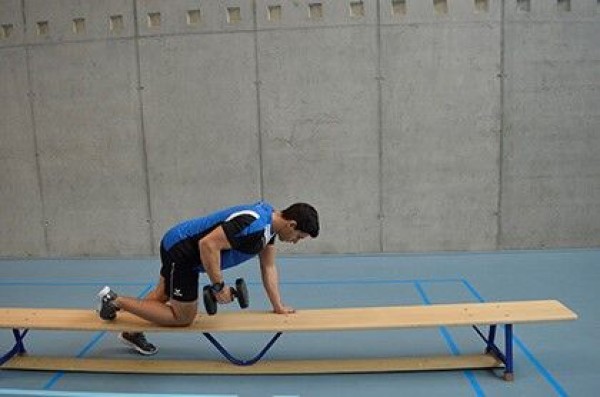
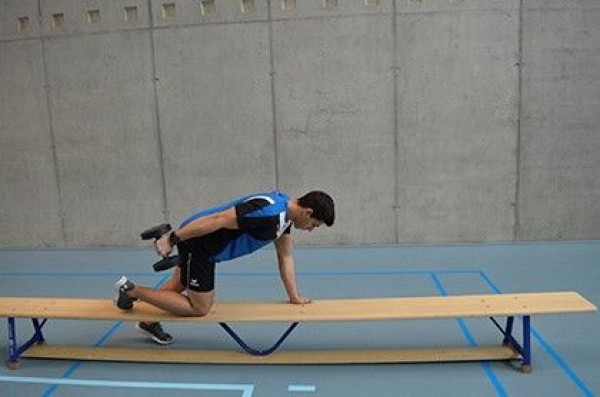
One-legged stand on the left, other leg (right) kneeling on the long bench (knee at standing leg height), one-armed support of the upper body on the long bench (supporting arm on the side of the standing leg), free arm (right) with the dumbbell in the hand close to the body stretched backwards in extension of the body, bend arm/elbow (approx. 90 degrees in the elbow joint) and stretch back to the starting position (lift and lower weight). 90 degrees at the elbow joint) and stretch back to the starting position (lift and lower the weight).
Attention:
Upper arm remains fixed (movement only at the elbow joint), straight back.
Lighten:
Less weight.
Harden:
More weight.
1 long bench
1 dumbbell
Extension and flexion of the arm in a kneeling position with the upper body supported (right) ► triceps extension
Power
Individual work
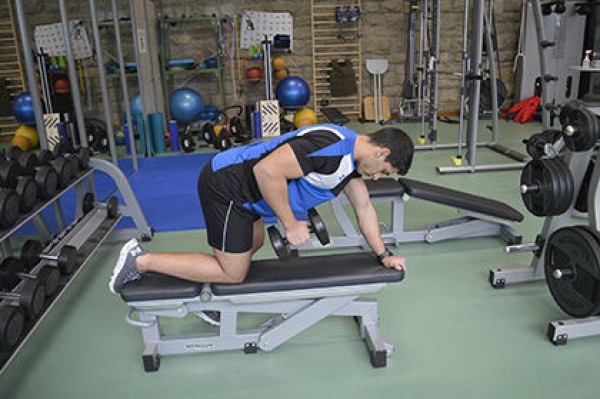
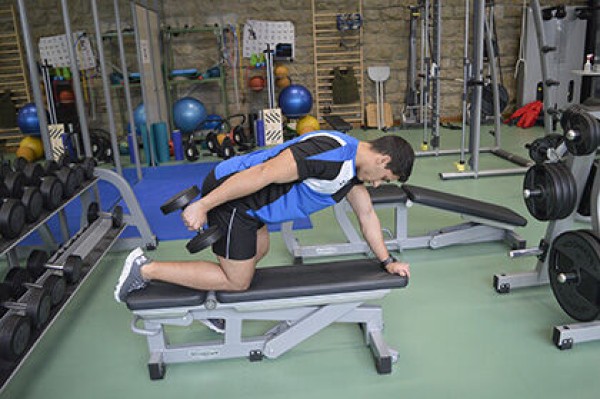
The body is supported with one knee and one arm on the flat bench (same side of the body, left). The other (right) foot is placed on the floor and the dumbbell is held in a neutral grip with the free (right) arm. The training arm is bent (approx. 90 degrees) so that the upper arm rests against the body (horizontal) and the lower arm points towards the floor (vertical). The arm is now stretched to bring the forearm into a horizontal position. The rest of the body remains still. Then bend the arm back to the starting position.
Starting position:
- Body is supported with one knee and one arm on the flat bench (same side of the body)
- Dumbbell in neutral grip
- Upper arm of the training arm is parallel to the back against the body
- Lower arm of the training arm points towards the floor (right angle in the elbow joint)
Finishing position:
- Training arm is parallel to the floor (stretched)
- Wrist remains stable
- Rest of body remains unchanged in the starting position.
Attention:
The movement (bringing the forearm into a horizontal position) is only performed from the elbow joint.
1 flat bench
1 dumbbell
Extension and flexion of the arm in a kneeling position with the upper body supported (rowing pull) (left) ► row 1-arm
Power
Individual work


One-legged stand on the left, other leg (right) kneeling on the long bench (knee at standing leg height), one-armed support of the upper body on the long bench (supporting arm on the opposite side of the standing leg), free arm (left) with the dumbbell/kettlebell in hand stretched down (almost) (hanging), pull dumbbell/kettlebell towards the body (chest) and accompany it back down (lift and lower weight).
Attention:
Do not fully extend your arm, keep your back straight, pull your elbows back up.
Lighten:
Less weight.
Harden:
More weight.
1 long bench
1 dumbbell/kettlebell
Extension and flexion of the arm in a kneeling position with the upper body supported (rowing pull) (right) ► row 1-arm
Power
Individual work


One-legged stand on the right, other leg (left) kneeling on the long bench (knee height of standing leg), one-armed support of the upper body on the long bench (supporting arm on the opposite side of the standing leg), free arm (right) with the dumbbell/kettlebell in hand stretched down (almost) (hanging), pull dumbbell/kettlebell towards the body (chest) and accompany it back down (lift and lower weight).
Attention:
Do not fully extend your arm, keep your back straight, pull your elbows back up.
Lighten:
Less weight.
Harden:
More weight.
1 long bench
1 dumbbell/kettlebell
Extension and flexion of the arm in push-up position (rowing pull) (left-right) ► row 1-arm push up position
Power
Partner work


Both participants stand at a distance of approx. 1 metre from each other in a frontal push-up position with their feet wide apart. With the opposite arm, the partners grasp the elasticated rubber band and extend the arm forwards as an extension of the body, with the rubber band under tension. Now both partners pull their arm sideways backwards past their body and extend it forwards again.
Attention:
Keep your torso stable and do not let it sag (constant tension).
Lighten:
Choose an elastic band with less resistance.
Harden:
Choose an elastic band with greater resistance.
1 elasticated rubber band
Extension and flexion of the arm in push-up position (row pull up) (left) ► cable high plank row / row 1-arm push up position
Power
Individual work

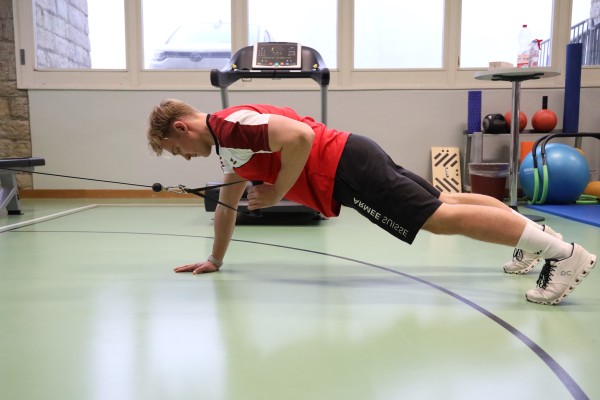
Push up position (high plank) frontally in front of the cable pull. Attach the rope pull at about head height. Grasp the handle of the cable pull with the left hand of the outstretched arm (adjust the distance). Bend your arm to bring the handle towards your chest, keeping your arm close to your body (elbow pointing backwards). Then stretch your arm back to the starting position.
Attention:
Keep the hull stable and do not allow it to sag (constant tension). The weight should not be put down at any time to keep the tension high.
Lighten:
Less weight.
Harden:
More weight.
1 weight tower/machine ► cable pulley (mid-high)
Extension and flexion of the arm in push-up position (left) ► row 1-arm push up position
Power
Individual work


In the push-up position, hold a dumbbell/kettlebell in one hand (left) with the other hand flat on the floor. In the push-up position, lift the dumbbell by bringing your elbow back towards your body (next to your ribcage). Then lower the weight back to the starting position in the push-up position (alternatively, do not lower the barbell). The movement only takes place in the elbow and shoulder joint, the rest of the body remains stable.
Starting position:
- Push-up position, one hand placed flat on the floor, the other hand resting on the barbell/kettlebell in a neutral grip
- Tension in the torso (no hollow back)
Finishing position:
- Dumbbell/kettlebell resting on/next to the body at approximately chest height
- Elbows of the arm to be trained bent behind the body and shoulder blades actively pressed together
- Tension in the torso maintained
Variant:
Combine the exercise with push-ups (i.e. after each repetition, you should take a break from the exercise).i.e. a push-up is performed after each repetition, which also works the chest and arm extensor muscles)
1 dumbbell/kettlebell
Extension and flexion of the arm in push-up position (row pull up) (right-left) ► row 1-arm push up position
Power
Partner work


Both participants stand at a distance of approx. 1 metre from each other in a frontal push-up position with their feet wide apart. With the opposite arm, the partners grasp the elasticated rubber band and extend the arm forwards as an extension of the body, with the rubber band under tension. Now both partners pull their arm sideways backwards past their body and extend it forwards again.
Attention:
Keep your torso stable and do not let it sag (constant tension).
Lighten:
Choose an elastic band with less resistance.
Harden:
Choose an elastic band with greater resistance.
1 elasticated rubber band
Extension and flexion of the arm in push-up position (row pull up) (right) ► cable high plank row / row 1-arm push up position
Power
Individual work


Push up position (high plank) frontally in front of the cable pull. Attach the rope pull at about head height. Grasp the handle of the cable pull with the right hand of the outstretched arm (adjust the distance). Bend your arm to bring the handle towards your chest, keeping your arm close to your body (elbow pointing backwards). Then stretch your arm back to the starting position.
Attention:
Keep the hull stable and do not allow it to sag (constant tension). The weight should not be put down at any time to keep the tension high.
Lighten:
Less weight.
Harden:
More weight.
1 weight tower/machine ► cable pulley (mid-high)